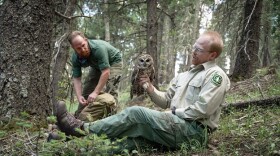
Danika Thiele
Danika Thiele is a Florida transplant, art enthusiast and environmental science writer. She worked previously as a food security and sanitation volunteer with Peace Corps Nepal. With her background in both agriculture and journalism, Danika combines her curiosity with the natural world to produce stories stemming from nature's peculiarities. You can catch Danika exploring the forest with her adventure partner, Dolly the supermutt.
-
Some things can only be found if you know exactly where to look. The Peebles Navajo Cactus, at less than 3 centimeters tall, doesn’t seem to want to be found. Its thorny spines mimic surrounding grit so closely, it nearly disappears into the sand.
-
Fire and drought are transforming western forests — and the Mexican Spotted Owl is adapting to survive.
-
The mighty saguaro cactus is both a cultural and ecological icon.
-
A cactus no bigger than a paperclip grows across the rocky eastern slopes of the Kaibab Plateau. Its thin, long spines protrude from its rotund body like a plump hedgehog.
-
At the Crane Petroglyph Heritage Site in the Verde Valley, visitors can reach through time for a glimpse of life in this place almost a thousand years ago.
-
Nestled within the shade of mixed-pine forests, freckled orchid flowers unfurl as small clusters on crimson stems. This is the lesser-known, native cousin to your orchid houseplant, called the spotted coralroot.
-
The San Francisco Peaks ragwort stands sentry over northern Arizona from its home on the San Francisco peaks. It grows close to the earth in unassuming, flat-topped clusters of blue-green leaves.
-
Northern Arizona is known for its roaming wildlife and the world’s largest contiguous ponderosa pine forest. This rugged, contrasting landscape beckons to species that need space to meander, yet many find themselves barricaded by the state’s cross-cutting interstates.
-
Cooler breezes crisp the air, as it shifts from the warmth of summer to the sharp invigoration of fall. Autumn is a season for the senses. The hues of stark crimsons and fiery oranges light up the hillsides, a cascading mix of nature’s brilliance.
-
Vast storm clouds wander the sky like roaming monoliths. Intense thunderstorms scour the desert and cool the land. Light shifts from piercing brilliance to dark and cataclysmic. Monsoon season is here. And with it, the plants and animals of the Colorado Plateau wake from slumber and come to life.











